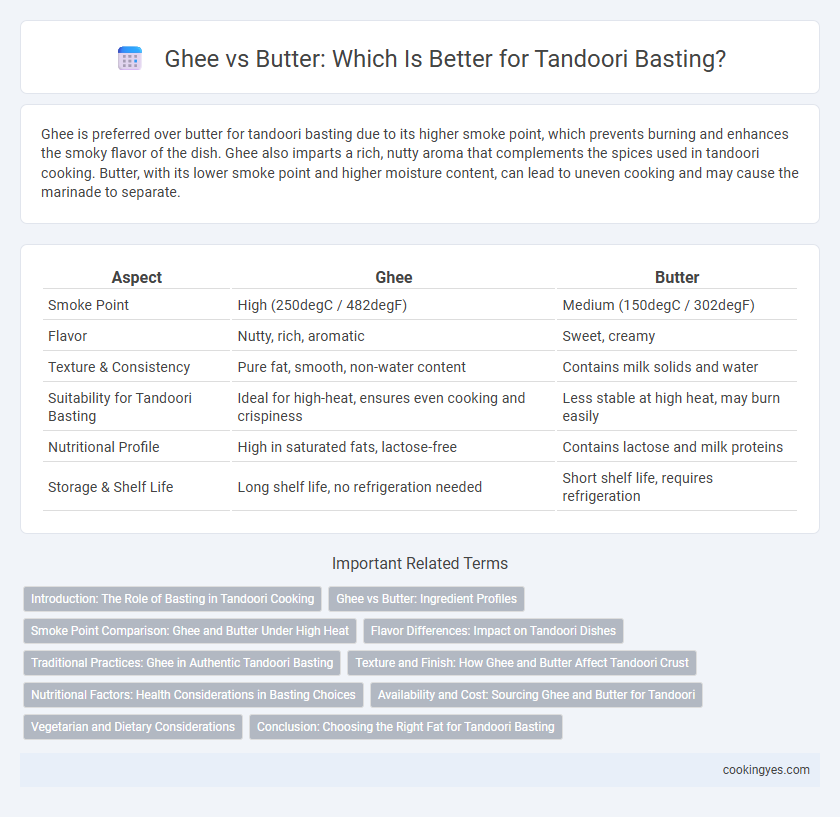Ghee is preferred over butter for tandoori basting due to its higher smoke point, which prevents burning and enhances the smoky flavor of the dish. Ghee also imparts a rich, nutty aroma that complements the spices used in tandoori cooking. Butter, with its lower smoke point and higher moisture content, can lead to uneven cooking and may cause the marinade to separate.
Table of Comparison
| Aspect | Ghee | Butter |
|---|---|---|
| Smoke Point | High (250degC / 482degF) | Medium (150degC / 302degF) |
| Flavor | Nutty, rich, aromatic | Sweet, creamy |
| Texture & Consistency | Pure fat, smooth, non-water content | Contains milk solids and water |
| Suitability for Tandoori Basting | Ideal for high-heat, ensures even cooking and crispiness | Less stable at high heat, may burn easily |
| Nutritional Profile | High in saturated fats, lactose-free | Contains lactose and milk proteins |
| Storage & Shelf Life | Long shelf life, no refrigeration needed | Short shelf life, requires refrigeration |
Introduction: The Role of Basting in Tandoori Cooking
Basting in tandoori cooking enhances flavor and moisture, crucial for achieving the dish's signature tender texture and smoky aroma. Ghee, with its high smoke point and rich, nutty flavor, intensifies the tandoori spices while preventing charring during high-heat cooking. Butter adds creaminess and a subtle sweetness but can burn easily, making ghee the preferred choice for authentic tandoori basting.
Ghee vs Butter: Ingredient Profiles
Ghee boasts a higher smoke point of around 485degF (252degC) compared to butter's 350degF (177degC), making it ideal for the high-heat environment of tandoori cooking. Rich in clarified fats and free of milk solids, ghee imparts a nutty flavor without the risk of burning, unlike butter which contains water and milk proteins that can burn quickly. This difference in ingredient profiles ensures ghee delivers better flavor retention and crispier basting results in traditional tandoori dishes.
Smoke Point Comparison: Ghee and Butter Under High Heat
Ghee has a higher smoke point of approximately 485degF (252degC), making it ideal for tandoori basting at high temperatures, while butter's smoke point is around 350degF (177degC), which can cause it to burn quickly under intense heat. The clarified nature of ghee removes milk solids, reducing the risk of smoking and imparting a rich, nutty flavor essential for authentic tandoori dishes. Using ghee ensures consistent heat distribution and flavor enhancement without the bitterness that burnt butter might introduce.
Flavor Differences: Impact on Tandoori Dishes
Ghee offers a rich, nutty flavor with a higher smoke point, enhancing the smoky aroma and crisp texture of tandoori dishes while preventing burning during high-heat cooking. Butter provides a creamier, slightly sweet taste that can mellow the spices but may burn faster, potentially altering the intended flavor profile. Choosing ghee over butter intensifies the traditional tandoori taste and supports authentic cooking techniques.
Traditional Practices: Ghee in Authentic Tandoori Basting
Traditional tandoori basting relies heavily on ghee due to its high smoke point and rich, aromatic flavor that enhances the smoky char of tandoori dishes. Ghee's clarified nature prevents burning at tandoor temperatures, making it ideal for maintaining moisture and imparting authentic taste. Butter, with its lower smoke point and milk solids, often burns quickly, altering the traditional flavor and texture in tandoori cooking.
Texture and Finish: How Ghee and Butter Affect Tandoori Crust
Ghee's high smoke point and clarified nature create a crisp, evenly browned tandoori crust with a slightly nutty finish, enhancing texture without sogginess. Butter, containing milk solids and water, tends to produce a softer crust with a richer, creamier finish but risks burning and uneven cooking under intense heat. The choice between ghee and butter directly impacts the crust's crunchiness and flavor complexity in authentic tandoori dishes.
Nutritional Factors: Health Considerations in Basting Choices
Ghee, clarified butter with a higher smoke point, offers a rich source of healthy fats and fat-soluble vitamins, making it ideal for high-heat tandoori basting. Butter contains more milk solids and water, leading to quicker burning and potential formation of unhealthy compounds under intense tandoori heat. Choosing ghee over butter enhances flavor while supporting heart health due to its lower lactose content and concentration of antioxidants.
Availability and Cost: Sourcing Ghee and Butter for Tandoori
Ghee, traditionally clarified butter, is widely available in South Asian markets and offers a longer shelf life compared to regular butter, making it a cost-effective option for tandoori basting. Butter, while less expensive per unit in Western markets, often requires refrigeration and spoils faster, increasing overall costs and logistical challenges for consistent tandoori cooking. The choice between ghee and butter depends on regional availability and cost considerations, with ghee being more practical for authentic, sustained tandoori preparation.
Vegetarian and Dietary Considerations
Ghee, clarified butter commonly used in Indian cuisine, offers a higher smoke point and richer flavor ideal for tandoori basting, enhancing vegetarian dishes without the milk solids found in regular butter. Butter contains lactose and milk proteins that may affect those with dairy sensitivities or dietary restrictions, making ghee a suitable alternative for lactose-intolerant or vegan-adapted preparations when carefully sourced. For vegetarians prioritizing authentic taste and digestibility, ghee provides a traditional, aromatic option that supports healthier cooking by reducing moisture and preventing flare-ups in the tandoor.
Conclusion: Choosing the Right Fat for Tandoori Basting
Ghee's high smoke point and rich, nutty flavor make it ideal for tandoori basting, ensuring even cooking and enhanced aroma without burning. Butter adds a creamy taste but can burn quickly under intense tandoor heat, potentially compromising the dish's texture. Opting for ghee preserves authentic tandoori flavor and provides better heat stability during the basting process.
Ghee vs Butter for tandoori basting Infographic

 cookingyes.com
cookingyes.com